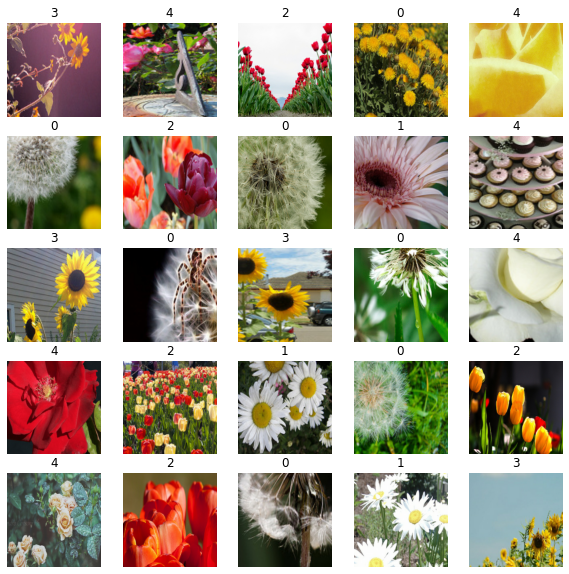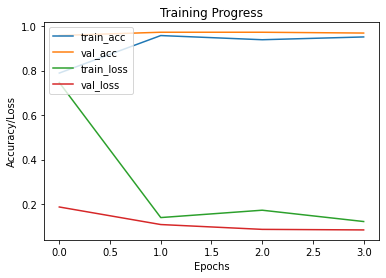使用BigTransfer (BiT) 进行图像分类
作者: Sayan Nath
创建日期 2021/09/24
最后修改日期 2024/01/03
描述: BigTransfer (BiT) 最先进的图像分类迁移学习。
简介
BigTransfer(也称为 BiT)是一种最先进的图像分类迁移学习方法。预训练表示的迁移提高了样本效率,并简化了在训练深度神经网络进行视觉任务时的超参数调整。BiT 重新审视了在大型监督数据集上进行预训练并在目标任务上对模型进行微调的范式。适当选择归一化层和随着预训练数据量的增加而调整架构容量的重要性。
BigTransfer (BiT) 在公共数据集上进行训练,并提供 TF2、Jax 和 Pytorch 代码。这将帮助任何人即使每类只有少量带标签的图像,也能在其感兴趣的任务上达到最先进的性能。
您可以在 TFHub 中找到在 ImageNet 和 ImageNet-21k 上预训练的 BiT 模型,它们作为 TensorFlow2 SavedModels 可以轻松用作 Keras 层。有各种尺寸可供选择,从标准的 ResNet50 到 ResNet152x4(152 层深,比典型的 ResNet50 宽 4 倍),适用于具有更大计算和内存预算但要求更高准确性的用户。
 图:x 轴显示每类使用的图像数量,范围从 1 到完整数据集。在左侧的图表中,上面蓝色的曲线是我们的 BiT-L 模型,而下面的曲线是在 ImageNet (ILSVRC-2012) 上预训练的 ResNet-50。
图:x 轴显示每类使用的图像数量,范围从 1 到完整数据集。在左侧的图表中,上面蓝色的曲线是我们的 BiT-L 模型,而下面的曲线是在 ImageNet (ILSVRC-2012) 上预训练的 ResNet-50。
设置
import os
os.environ["KERAS_BACKEND"] = "tensorflow"
import numpy as np
import pandas as pd
import matplotlib.pyplot as plt
import keras
from keras import ops
import tensorflow as tf
import tensorflow_hub as hub
import tensorflow_datasets as tfds
tfds.disable_progress_bar()
SEEDS = 42
keras.utils.set_random_seed(SEEDS)
收集花卉数据集
train_ds, validation_ds = tfds.load(
"tf_flowers",
split=["train[:85%]", "train[85%:]"],
as_supervised=True,
)
[1mDownloading and preparing dataset 218.21 MiB (download: 218.21 MiB, generated: 221.83 MiB, total: 440.05 MiB) to ~/tensorflow_datasets/tf_flowers/3.0.1...[0m
[1mDataset tf_flowers downloaded and prepared to ~/tensorflow_datasets/tf_flowers/3.0.1. Subsequent calls will reuse this data.[0m
可视化数据集
plt.figure(figsize=(10, 10))
for i, (image, label) in enumerate(train_ds.take(9)):
ax = plt.subplot(3, 3, i + 1)
plt.imshow(image)
plt.title(int(label))
plt.axis("off")

定义超参数
RESIZE_TO = 384
CROP_TO = 224
BATCH_SIZE = 64
STEPS_PER_EPOCH = 10
AUTO = tf.data.AUTOTUNE # optimise the pipeline performance
NUM_CLASSES = 5 # number of classes
SCHEDULE_LENGTH = (
500 # we will train on lower resolution images and will still attain good results
)
SCHEDULE_BOUNDARIES = [
200,
300,
400,
] # more the dataset size the schedule length increase
超参数如 SCHEDULE_LENGTH 和 SCHEDULE_BOUNDARIES 是根据经验结果确定的。该方法已在原始论文和他们的Google AI 博客文章中进行了解释。
SCHEDULE_LENGTH 也决定是否使用 MixUp 增强。您还可以在 Keras 编码示例中找到一个简单的 MixUp 实现。

定义预处理辅助函数
SCHEDULE_LENGTH = SCHEDULE_LENGTH * 512 / BATCH_SIZE
random_flip = keras.layers.RandomFlip("horizontal")
random_crop = keras.layers.RandomCrop(CROP_TO, CROP_TO)
def preprocess_train(image, label):
image = random_flip(image)
image = ops.image.resize(image, (RESIZE_TO, RESIZE_TO))
image = random_crop(image)
image = image / 255.0
return (image, label)
def preprocess_test(image, label):
image = ops.image.resize(image, (RESIZE_TO, RESIZE_TO))
image = ops.cast(image, dtype="float32")
image = image / 255.0
return (image, label)
DATASET_NUM_TRAIN_EXAMPLES = train_ds.cardinality().numpy()
repeat_count = int(
SCHEDULE_LENGTH * BATCH_SIZE / DATASET_NUM_TRAIN_EXAMPLES * STEPS_PER_EPOCH
)
repeat_count += 50 + 1 # To ensure at least there are 50 epochs of training
定义数据管道
# Training pipeline
pipeline_train = (
train_ds.shuffle(10000)
.repeat(repeat_count) # Repeat dataset_size / num_steps
.map(preprocess_train, num_parallel_calls=AUTO)
.batch(BATCH_SIZE)
.prefetch(AUTO)
)
# Validation pipeline
pipeline_validation = (
validation_ds.map(preprocess_test, num_parallel_calls=AUTO)
.batch(BATCH_SIZE)
.prefetch(AUTO)
)
可视化训练样本
image_batch, label_batch = next(iter(pipeline_train))
plt.figure(figsize=(10, 10))
for n in range(25):
ax = plt.subplot(5, 5, n + 1)
plt.imshow(image_batch[n])
plt.title(label_batch[n].numpy())
plt.axis("off")

将预训练的 TF-Hub 模型加载到 KerasLayer 中
bit_model_url = "https://tfhub.dev/google/bit/m-r50x1/1"
bit_module = hub.load(bit_model_url)
创建 BigTransfer (BiT) 模型
要创建新模型,我们
-
切断 BiT 模型的原始头部。这给我们留下了“预 logits”输出。如果使用“特征提取器”模型(即所有标题为
feature_vectors子目录中的模型),则无需执行此操作,因为对于这些模型,头部已被切断。 -
添加一个新的头部,其输出数量等于新任务的类别数量。请注意,将头部初始化为全零很重要。
class MyBiTModel(keras.Model):
def __init__(self, num_classes, module, **kwargs):
super().__init__(**kwargs)
self.num_classes = num_classes
self.head = keras.layers.Dense(num_classes, kernel_initializer="zeros")
self.bit_model = module
def call(self, images):
bit_embedding = self.bit_model(images)
return self.head(bit_embedding)
model = MyBiTModel(num_classes=NUM_CLASSES, module=bit_module)
定义优化器和损失
learning_rate = 0.003 * BATCH_SIZE / 512
# Decay learning rate by a factor of 10 at SCHEDULE_BOUNDARIES.
lr_schedule = keras.optimizers.schedules.PiecewiseConstantDecay(
boundaries=SCHEDULE_BOUNDARIES,
values=[
learning_rate,
learning_rate * 0.1,
learning_rate * 0.01,
learning_rate * 0.001,
],
)
optimizer = keras.optimizers.SGD(learning_rate=lr_schedule, momentum=0.9)
loss_fn = keras.losses.SparseCategoricalCrossentropy(from_logits=True)
编译模型
model.compile(optimizer=optimizer, loss=loss_fn, metrics=["accuracy"])
设置回调
train_callbacks = [
keras.callbacks.EarlyStopping(
monitor="val_accuracy", patience=2, restore_best_weights=True
)
]
训练模型
history = model.fit(
pipeline_train,
batch_size=BATCH_SIZE,
epochs=int(SCHEDULE_LENGTH / STEPS_PER_EPOCH),
steps_per_epoch=STEPS_PER_EPOCH,
validation_data=pipeline_validation,
callbacks=train_callbacks,
)
Epoch 1/400
10/10 [==============================] - 18s 852ms/step - loss: 0.7465 - accuracy: 0.7891 - val_loss: 0.1865 - val_accuracy: 0.9582
Epoch 2/400
10/10 [==============================] - 5s 529ms/step - loss: 0.1389 - accuracy: 0.9578 - val_loss: 0.1075 - val_accuracy: 0.9727
Epoch 3/400
10/10 [==============================] - 5s 520ms/step - loss: 0.1720 - accuracy: 0.9391 - val_loss: 0.0858 - val_accuracy: 0.9727
Epoch 4/400
10/10 [==============================] - 5s 525ms/step - loss: 0.1211 - accuracy: 0.9516 - val_loss: 0.0833 - val_accuracy: 0.9691
绘制训练和验证指标
def plot_hist(hist):
plt.plot(hist.history["accuracy"])
plt.plot(hist.history["val_accuracy"])
plt.plot(hist.history["loss"])
plt.plot(hist.history["val_loss"])
plt.title("Training Progress")
plt.ylabel("Accuracy/Loss")
plt.xlabel("Epochs")
plt.legend(["train_acc", "val_acc", "train_loss", "val_loss"], loc="upper left")
plt.show()
plot_hist(history)

评估模型
accuracy = model.evaluate(pipeline_validation)[1] * 100
print("Accuracy: {:.2f}%".format(accuracy))
9/9 [==============================] - 3s 364ms/step - loss: 0.1075 - accuracy: 0.9727
Accuracy: 97.27%
结论
BiT 在令人惊讶的广泛数据范围(从每类 1 个样本到总共 100 万个样本)中表现出色。BiT 在 ILSVRC-2012 上实现了 87.5% 的 top-1 准确率,在 CIFAR-10 上实现了 99.4%,在 19 个任务的 Visual Task Adaptation Benchmark (VTAB) 上实现了 76.3%。在小型数据集上,BiT 在 ILSVRC-2012 上每类 10 个样本时达到 76.8%,在 CIFAR-10 上每类 10 个样本时达到 97.0%。

您可以按照原始论文进一步试验 BigTransfer 方法。

